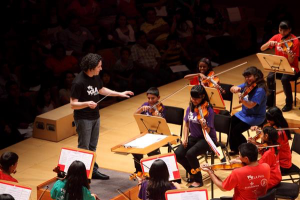Music training strengthens children’s brains, decision-making network
The new study by the Brain and Creativity Institute at USC is the latest in a series examining how le arning to play and read music may enhance children’s brains and their emotional and intellectual development.
arning to play and read music may enhance children’s brains and their emotional and intellectual development.
Contact: Zen Vuong, (213) 300-1381 orzvuong@usc.edu
If the brain is a muscle, then learning to play an instrument and read music is the ultimate exercise.
Two new studies from the Brain and Creativity Institute at USC show that as little as two years of music instruction has multiple benefits. Music training can change both the structure of the brain’s white matter, which carries signals through the brain, and gray matter, which contains most of the brain’s neurons that are active in processing information. Music instruction also boosts engagement of brain networks that are responsible for decision making and the ability to focus attention and inhibit impulses.
The benefits were revealed in studies published recently in scientific journals — including one this week in the journal Cerebral Cortex.
The results are from an ongoing longitudinal study that began in 2012, when BCI at the USC Dornsife College of Letters, Arts and Sciences established a partnership with the Los Angeles Philharmonic Association and Heart of Los Angeles (HOLA) to examine the impact of music instruction on children’s social, emotional and cognitive development.
The neuroscientists have been monitoring the brain development and behavior of a group of children from underserved neighborhoods in Los Angeles. Some of the children are learning to play and read music through the Youth Orchestra Los Angeles at HOLA.
To examine the impact of music training on their brains, the scientists have utilized several scientific techniques, including structural and functional MRI scans, EEG to track electrical activity in the brains, and behavioral testing.
Initial results published last year showed that music training accelerates maturity in areas of the brain that are responsible for sound processing, language development, speech perception and reading skills.
“Together these results demonstrate that community music programs such as Youth Orchestra Los Angeles can offset some of the negative consequences that low socio-economic status can have on child development,” said Assal Habibi, the study’s lead author and an assistant research professor of psychology at BCI in USC Dornsife College.
A growing body of research has shown that poverty can greatly disrupt or hinder brain development for children, affecting their performance in school.
An ensemble of children
For the latest studies, the neuroscientists tracked and monitored changes in 20 children who had started learning to play and read music through the Los Angeles Philharmonic’s Youth Orchestra Los Angeles program at HOLA at age 6 or 7. The community music training program resembles one that Los Angeles Philharmonic music and artistic director Gustavo Dudamel had been in when he was growing up in Venezuela, there known as El Sistema.
The Youth Orchestra Los Angeles students in this study learned to play instruments, such as the violin, in ensembles and groups, and they practice up to seven hours a week.
The scientists also compared the musicians to peers in two other groups: 19 children in a community sports program, and, as a control group, 21 children who were not involved in any specific after-school programs.
A developmental crescendo
In the BCI study published this week, children receiving music instruction, compared to peers, demonstrated changes in thickness and volume of brain regions that are engaged in processing sound.
These regions, called “auditory association areas,” are located just above the ears. Cortical thickness is a reliable measure of brain maturity.
Children who have received music training showed differences in the thickness of the auditory areas in the right versus the left hemisphere, a sign that music training impacts brain structure. In addition, children learning to play and read music showed a stronger robustness of the white matter, a sign of stronger connectivity in the corpus callosum, an area that allows communication between the two hemispheres of the brain.
“There has been a long suspicion that music practice has a beneficial effect on human behavior. But this study proves convincingly that the effect is real,” said Antonio Damasio, University Professor and director of the Brain and Creativity Institute.
In another study published two weeks ago in the journal PLoS One, the neuroscientists at BCI found that when the young musicians were performing an intellectual task, they demonstrated greater engagement of a brain network that is involved in executive function and decision-making.
For the task, known in psychology research as the “color-word Stroop task,” children were presented with a word whose meaning at times matched its color.
For example, the word “blue” appeared in blue font. In some instances, however, there was an incongruency, such as the word blue appearing in a red font. To test their impulse control and decision-making abilities, children were asked to ignore the written words and instead name the color of the word. Children completed the task while undergoing an MRI scan, which tracked the differences in brain responses between children learning music and those who were not.
“We have documented longitudinal changes in the brains of the children receiving music instruction that are distinct from the typical brain changes that children that age would develop,” Habibi said. “Our findings suggest that musical training is a powerful intervention that could help children mature emotionally and intellectually.”
The study was supported by the Brain and Creativity Institute Research Fund.
BCI co-directors Antonio Damasio and Hanna Damasio were co-authors of the study. Other co-authors were BCI research associate Ryan Veiga; Beatriz Ilari of the USC Thornton School of Music; as well as Anand Joshi, Justin Haldar and Richard Leahy of the USC Viterbi School of Engineering.
The co-authors of the PLOS One study published on Oct. 30 included Jonas Kaplan, Matthew Sachs and Alissa Der Sarkissian, all at BCI.
#
